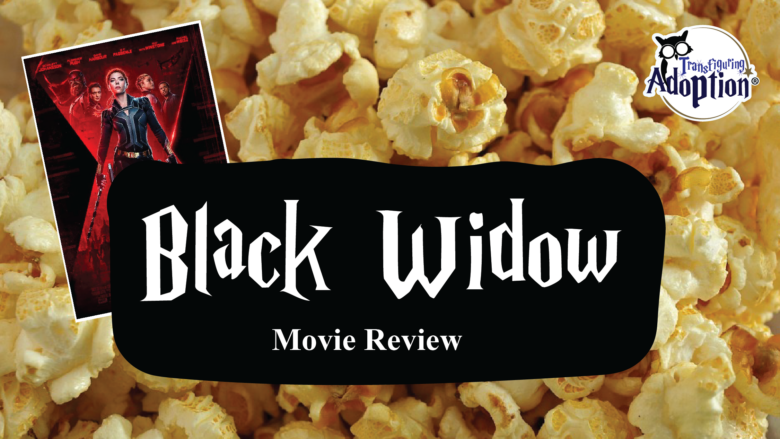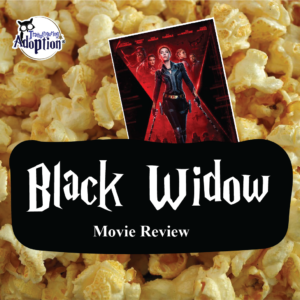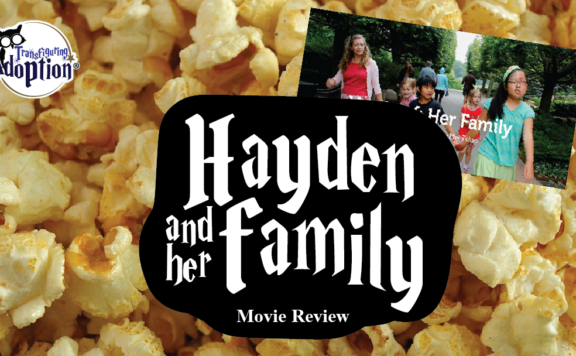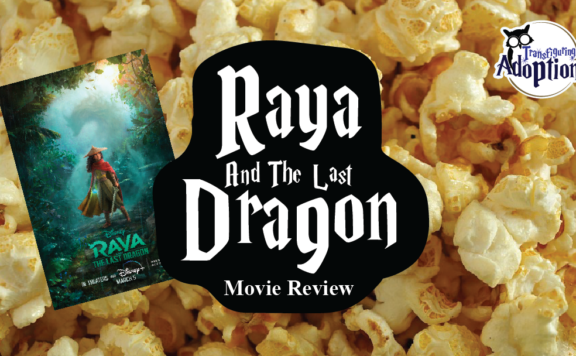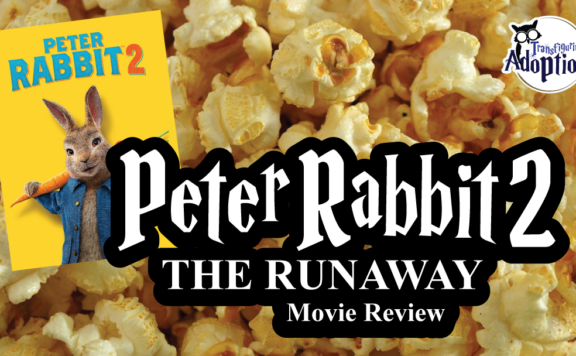Grade:
Transfiguring Adoption awarded this movie 3 Hoots out of 5 based on how useful it will be for a foster/adoptive family. [Learn more about our Hoot grading system here]
Movie Info:
-
Rating: PG-13 (Some Language, Intense Violence/Action, Thematic Material)
-
Genre: Action, Adventure
-
Runtime: 133 minutes
-
Studio: Marvel Studios
From the Cover of Black Widow (2021) by Marvel Studios:
“In Marvel Studios’ action-packed spy thriller “Black Widow,” Natasha Romanoff aka Black Widow confronts the darker parts of her ledger when a dangerous conspiracy with ties to her past arises. Pursued by a force that will stop at nothing to bring her down, Natasha must deal with her history as a spy and the broken relationships left in her wake long before she became an Avenger.”
Transfiguring Adoption’s Overview:
Black Widow (2021) is part of the extensive Marvel Cinematic Universe (MCU) and tells the back-story of Natasha Romanoff (Black Widow), former Russian super-spy and one of the Avengers. Overall the film itself was a good action film with lots of drama and just enough humor to balance the darker scenes in typical Marvel Studios fashion. Children with trauma will definitely identify with Natasha as more context is given to her very traumatic past. Fans of the Marvel Cinematic Universe will definitely want to see this movie to learn more about the beloved Black Widow (and see the post-credits cutscene to find out what’s next) but caregivers should proceed with caution if their teen has a history of feeling “taken away” in childhood or struggles with themes with dysfunctional family dynamics.
The target audience appears to be children that are 13 and up. Caregivers should note this is not a “kids movie” at all and will have more mature themes and a longer run time due to this being a film for a more mature audience. It also appears this movie would be fun for most families of teens for an entertaining action movie.
** Spoilers Could Be Ahead **
How Is This Relevant To Adoption & Foster Care?
Black Widow (2021) is the much-anticipated origin story for Natasha Romanoff, aka Blackwidow, of the Avengers. What was not expected was the story moves back and forth between her formative years and while being on the run after the events of Captain America: Civil War (2016). The part that children with trauma may really identify with though is Natasha’s family dynamic.
It’s revealed through the events of the movie that Natasha was removed from her family of origin as a baby. Her family was paid off after Draykov and his Black Widow Ops Program due to her genetic potential to become a Widow, a superspy controlled by the Red Room. It is later revealed that Natasha’s mother never stopped looking for her until Draykov had her killed to prevent his program from being discovered. Natasha is raised by a surrogate family of Alexei Shostakov (aka Red Guardian, the less-popular Russian equivalent of Captain America) and Black Widow Melina Vostokoff along with younger surrogate sister, Yelena Belova. In 1995 their sleeper cell in Ohio is discovered leading to them being separated until the events following Captain America: Civil War (2016). In addition to resolving unfinished business with the Red Room for the spy family, Natasha also faces off with Taskmaster who turns out to be a victim of her attempt to kill Draykov when she defected as an adult. The entire family over time has to come to terms with their own unresolved expectations about the family dynamics and their respective trauma from the Red Room and the Black Widow Ops Program over the course of the film.
This family is filled with potential trauma triggers, both those I’d expect from an action movie and some I did not. While this movie could have the potential to be harmful to a teen with a traumatic background such as being a foster or adoptive child, there are moments of redemption and closure that can really provide some great conversation with a caring adult. This can actually be an experience that, through processing in a safe and loving relationship, can help provide insight into deep feelings about trauma and separation from biological or past surrogate family.
Discussion Points:
- Reframing Memories
Throughout the film Natasha is revisiting memories of her past, especially pertaining to the time she spent with her surrogate family in Ohio prior to 1995. Whenever Natasha and Yelena discuss these experiences though it is clear each woman has different emotions and perspectives attached to the same events. Natasha’s memories are more tinged with pain and feelings of “fake” while Yelena truly views that time as the only family she has ever known and acknowledges her feelings of attachment to her mother, father, and sister. Children that have endured trauma can often have the same dynamic as Natasha and Yelena about how they view their trauma, even if they are biologically related. Caregivers need to be prepared for when their teen discusses painful experiences or memories to sometimes have varying accounts of the same event. Even if the same teen processes the same event differently with each retelling this is not necessarily a deceit tactic. This is a very normal part of a teen coming to terms with their past and eventually finding a way to integrate all of the complex feelings they have about people they care for. We later find out that Natasha, though her feelings are raw and painful, really does regard her dysfunctional spy-surrogate parents with much love and respect but is processing her own trauma through these memories and feelings. While therapy is an amazing tool that I hope your teen is engaging in, having unconditional support and love for your teen ready between sessions is equally important as they tackle these deeply hurtful feelings. - Generational Trauma
During the course of the film we discover that Natasha’s surrogate mom and dad also have their demons to face once she reunites with them. Alexei reveals that not only is he not as connected to Draykov, he was ultimately betrayed and left to rot in prison following the 1995 sleeper cell event. He still wrestles with what he could have been as Red Guardian and ruminates constantly over how Captain America rose to the fame he aspired to. Black Widow Melina Vostokoff also reveals to Natasha that in addition to all the missions and traumatic separations she herself has also visited the ominous Red Room (implied to have endured torture and experiments on herself during). With this it’s clear that Yelena and Natasha are not only carrying their own trauma but the weight of their surrogate parents’ traumas as well. This is a similar dynamic to what children with trauma have. Often when caregivers are caring for children with trauma it is easy to get mad at the child’s parents. This is completely normal and understandable, but caregivers need to remember that very seldom do parents intend to harm their children. Much like Alexei and Melina, many parents of children with extensive trauma histories are wrestling with traumas of their own and did not have a caring adult to walk through it with them. They are also survivors of trauma that show the effects of trauma that is not transformed and instead is transferred to the next generation. For this reason Black Widow (2021) can open up conversations that will provide some context for why some parents while, well meaning, may struggle with transferring trauma to their children. - Defining Family
This movie explores the definition of family extensively. Natasha explores what family means through her biological family (i.e. – her biological mother), her surrogate spy-family, and her found-family in the (now splintered) Avengers. Like Natasha, children that have been through the child welfare system may have very different family dynamics from what you are used to if you grew up with your family of origin. Some children may have had 10 or more foster families and others may have a close network of neighbors that function like aunties and uncles. Some children may only have connections to an adoptive family. And sometimes folks are not connected to people from their past at all (much like Natasha was assumed to be prior to this film) and need to make their own connections in the form of found family bonds. None of these connections are bad or wrong and when a child or teen has the chance to integrate a combination of connections to their family tree this can be a wonderful, messy experience. Some of these connections may be painful, but all of them are meaningful and deserving of the honor a teen chooses to bestow on each connection because each connection did help in forming the powerful, resilient human they are today. For this reason it’s good for caregivers to take care in how they refer to the term “family”. Remember, just because a family member is not physically present right now they still have left a piece of themselves in your child’s identity so if you disrespect that family connection you may be inadvertently disrespecting your child by proxy. And we very much want children that have been through trauma to know that they are deserving of love and respect no matter what.
Cautionary Points:
- All the Violence!!
I cannot state this enough: THIS IS NOT A KIDS MOVIE!!! Please keep that in mind. There is a lot of violence in this film since we are dealing with a character with a background in espionage and contract killing. Natasha has killed many people and other characters in the film harm, maim, and kill others. There are frequent fight scenes that feature guns, knives, missiles, hand-to-hand combat, choke holds with curtains, apparent harm to an animal (i.e. – stopping it from breathing for extended time), cars and people being knocked of bridges, a floating villain lair crashing towards Earth, SWAT-team responses, falling from buildings, rooftop fights, skydiving fights with debris flying everywhere, a crazy fatal avalanche, self-harm (i.e. – Natasha slamming her head on a desk as a tactical move, carving a tracker out of body, etc.), and intentional harm through graphic car/motorcycle/plane/helicopter/armored vehicle chases, wrecks and explosions. Remember, children that have been through trauma sometimes can self-sabotage in response to bursts of adrenaline even from fun experiences like enjoying an action movie because this is the same neural pathway their traumatized brain goes through when they are experiencing fight-or-flight responses to danger. This means your child could potentially act out with survival behaviors or have nightmares in response to the violence depicted in this movie. - Depictions of Human Trafficking
Natasha has in light terms discussed her time prior to the Avengers in other films, but this film showing visually may be upsetting to some viewers (and rightfully so, this was something that triggered myself as an experienced caseworker). In addition to seeing children being drugged via syringes to the neck and hauled off by armed soldiers after a gun-to-gun stand off we see parts of the brainwashing techniques employed by the Black Widow Ops Program, girls being transported in shipping crates, a sting-operation, various scenes of being hidden or hiding from the police, children being held at gunpoint, and various graphic descriptions of the Widows having their uteruses removed during the Red Room. It is also clear that the Widows have their appearances altered via unmedicated cranial procedures and other methods that are barbaric and outright torture. Again, please proceed with caution if themes like this potentially could be too much for your teen. - Problematic Family Dynamics
When the film opens, we see two young girls living what seems to be a typical suburban family life. However, we learn throughout the course of the movie that the caregiver figures were both Russian spies and that the ‘family’ was just a ruse as part of a mission. Natasha, the older sister, knew this at the time, but Yelena, the younger one, did not. Additionally, we see those same caregivers make poor choices that expose the girls to harm, refer to the family as ‘not real’, and say some troubling things about love. In the end we see them make positive choices and put Yelena and Natasha first, and protect them. However, these scenes and concepts may be confusing for children who are struggling to understand their own removal from biological family or how they fit into a foster/adoptive family. - Traumatic removal from “Caregivers”
As mentioned in the point above, Yelena and Natasha are very young children in the film’s opening sequence. We learn later that the whole ‘family’ they were in was a ruse, but in the moment they appear to be simply two parents fleeing from their home with their parents. During this escape their ‘mother’ is injured and their ‘father’ hands them over to armed military personnel. The children are dragged off screaming and crying while the ‘father’ watches on with no apparent emotion. Again, we later learn that Natasha knew that the ‘family’ was a ruse, but Yelena never did. Either way it’s a very heartbreaking scene to watch and may be especially upsetting for children who experienced a traumatic removal from their birth parents. - Sibling Separation
Going along with the above two cautionary points, when Yelena and Natasha are handed over to the Russian soldiers to return to the Red Room they end up being separated from one another. We later learn that they did not see one another for many years, and did not really know what happened to the other during that time. These scenes of separation and reunification may be difficult for children who are still processing the loss/separation from their own siblings. - Negative Association with Police
Throughout the film’s two arcs, young Natasha runs from the police/SHIELD due to being a part of a Russian sleeper cell organization and again in present time due to the events following the Sokovia Accords where the Avengers are labeled as wanted felons and vigilantes. Across the board in addition to fighting “bad guys” Natasha and her companions are engaging in a lot of illegal activity to avoid detection and arrest. This could be highly triggering for children who have negative associations with armed forces due to past experiences with trauma and present issues pervasive in some communities. Please proceed with caution if this is a concern for your teen. - Depictions of Prison Life
I wasn’t quite sure how else to word this one, but the showing of Alexei in prison can be difficult for some viewers. In addition to the whole idea of him receiving a prison tattoo while actively arm wrestling other prisoners, he actually breaks one man’s arm in multiple places. While no blood or bone is shown in this specific scene, it is pretty graphic and you can tell the whole arm is misaligned in multiple places. This made me gag personally. Proceed with caution if such instances of violence are problematic for your teen. - Lots of Alcohol
I guess since the main characters are implied or are Russian spies the use of Vodka should not have been so surprising but it was! Throughout the movie there are several sequences of characters drinking vodka straight from bottles. This would be less concerning (stereotypes aside) if not for the fact that the alcohol consumption is combined with scenes where characters are discussing hard, hurtful emotions and relationships. Children that have been through trauma sadly have seen what happens when an adult uses alcohol to cope with hard situations and potentially have seen violent reactions to drinking so this can potentially be triggering to some teens in this context. - Children/Younger Characters Shown as Equal to or More Mature than Caretaking Adults
During the film, it is shown that in 1995 Ohio’s escape from SHIELD Natasha actually has to take over plane controls during the escape due to Melina being shot in front of her and Alexei exchanging gunfire on the plane’s wing. There are several harsh critiques from Natasha and Yelena for Melina and Alexei’s parenting, including calling them cowards for not standing up to Draykov and mocking Alexei’s desire to live in the past as Red Guardian. Though for most of this Natasha and Yelena are adults, it is still difficult to see dynamics of children having to “be the adult” even long after they are grown. This does not exclude your teens with trauma as well. Such depictions also make it difficult for children and teens to trust adults when they have already had poor examples of caring adults in the past. This film does redeem the adults (as it turns out Melina especially is in on Natasha’s espionage plan and doesn’t actually sell them out) this can still be harmful for a teen that is still actively working through trauma of this sort. - Foul Language
Though most of it is in Russian, the terms “bitch”, “douchebag”, “dipshit”, etc. are all used in Russian through subtitles. Please be aware because while most teens can probably handle this level of language you may want to reinforce with younger teens your expectations with foul language use prior to viewing… and remind them that it still counts if it’s in another language. - Graphic First Aid Scene
Natasha snaps her nose back into place after severing her olfactory nerve temporarily after a fight. While this is a more specific trigger, some teens may find this gross and cringy. - Off-Screen Killing of a Child
This is the implied-death of Antonia, Draykov’s daughter, during flashbacks on a mission deployed by Natasha. It turns out later that she is the cyborg Taskmaster, but throughout the film Natasha is guilted and reminded of her having killed Antoina in her assassination attempt for Draykov. While this is an off-screen assassination, caretakers should still be aware in case a child in mortal peril is triggering for your teen.
Discussion Guide:
- Why did Yelena and Natasha seem to remember living in Ohio prior to 1995 so differently?
Caregiver Note: While Yelena and Natasha had the same experiences living with Alexei and Melina they had very different ways of how they remember those experiences. While Natasha is quick to point out short-falls of their surrogate parents and how they weren’t a “real” family, Yelena points out that this was literally the only family she ever knew and that it was “real” for her. In the same way, children in the same sibling group may also frame memories differently based on their ages, emotional ages at the time of trauma, their resilience, and just how they personally react to instances of trauma. Because Natasha longs for a connection with her biological family and has experienced some bonding outside of the Black Widow Ops Program, it makes sense that Natasha would draw on these experiences and compare them. Much like Natasha, your teen may need help talking through these things and honoring their very valid emotions, good and bad, so caregivers should be prepared to engage in some hard talks of this nature. - How come Natasha seemed to change her mind on how she viewed the Ohio family? What changed?
Caregiver Note: Over the course of the film, Natasha gets a lot more context for why her surrogate parents behaved the way they did. Alexei being immature and braggadocious? That was a cover for being betrayed and discarded so harshly by Draykov after his years of service, longing for what could have been. Melina didn’t fight back, not because she was a coward but because she was literally programmed like the others to be unable to fight back and was tortured in the same ways as all the Widows. Sometimes with time, new experiences, and information like this your teen may cycle through different ways of how they view their past. Sometimes with rose-colored glasses, and sometimes seething with pain and rage. No matter what, all of these feelings are valid and do have space for acknowledgement and honor. This is where you, the caregiver that is stronger, wiser, and kinder can help organize these very messy feelings and show your teen lots of love and patience while they cycle through the various emotions they may experience in the safety of your home. - Has there ever been a time where you felt one way about a memory but over time it changed?
Caregiver Note: This may be a hard question for your teen depending on their level of insight into their own emotions and their level of trust in you. It’s okay to let your teen guide how far this one goes. If we try too hard to force these emotions it can be difficult. This does not have to be a one-time discussion and can be a theme that is revisited again off and on to check in with your teen as they progress through therapy and development. - What were the best parts of how Alexei and Melina raised Natasha and Yelena? What were the not-so-great parts?
Caregiver Note: Your teen may or may not have noticed, but even through Natasha’s perspective we see some strengths in Alexei and Melina in addition to their weaknesses. Alexei appears to be very protective and uses his physical strength and resources to the best of his knowledge to take care of the girls. He also exposes the girls to music and other fun things we see in the photobook. Melina is kind and caring, and pays attention to the girls’ needs while in play or in mealtimes. This doesn’t even touch on her tactical prowess and intelligence either. However, as adults with their own unresolved trauma they have some pretty prominent weaknesses. Alexei is easy to trigger fits of rage from, impulsive, self-absorbed, and really not a very bright dude. Melina is manipulative, cold, calculating, and very much focused on her own survival throughout the experiences. While they each get redemption in the end, both adults show how in not dealing with their own past traumas they transferred some of that trauma to the children in their care. This, along with the trauma suffered from being trafficked and tortured, just adds to the dysfunction we see in Natasha’s ability to form relationships with her fellow Avengers. - Why did Alexei and Melina struggle in their roles and parents even though they “acted the part”?
Caregiver Note: While Alexei and Melina may have “studied up” on their “roles” as parents, they didn’t really do the internal work needed to parent a child with trauma. As a caretaker yourself you may have come across situations by now that have triggered something in you. It is important for caregivers to not hide these feelings but to find healthy ways to cope with and process these triggers. Like Alexei and Melina, we risk transferring our trauma to our children when we choose to push away the personal inner work required to achieve self-actualization and to heal the trauma in our children. While talking through these parts, think of ways you can help soothe your inner traumas as well. Trust me, not only do you deserve it anyway but this will greatly help you in your parenting down the line even if you haven’t needed to yet. - What are things you would like to work on before you get older, like Natasha?
Caregiver Note: One great thing about this film is that in addition to seeing caretaking adults get their unfinished business taken care of we also see Natasha continuing her internal work through the course of this film. Natasha has endured a lot of trauma and certainly needs a lot of therapy and support. It is fantastic to see Natasha work through the unresolved things about her identity as a part of a family (biological/surrogate/found). This can be another area of inspiration to talk to your child about their personal goals for growth. This response may vary based on your child’s comfort level and level of trust in you but, again, can always be revisited. This really is a wonderful way to frame talking about internal work as your teen may struggle to make these abstract connections on their own. - How many families does Natasha have?
Caregiver Note: This is a great question to engage your child into the story. Natasha does mention having multiple families, but how many are there really? Ultimately the main focus we see are the mother Natasha never knew that never stopped looking for her, the surrogate family, and her Avengers that have become her found family. - What family does Yelena focus most on?
Caregiver Note: Because of Yelena’s age, to her the surrogate spy family of Natasha, Melina, and Alexei are her true family. By the end of the film we can also identify a familial bond with the other Black Widows as they return for her and set out to rescue the other Black Widows from the mind-control bondage. Though at first Yelena’s only “family” was that surrogate family, by the end of it Yelena was able to move forward with an expanded sense of family and more connections than when she only regarded those that raised her as family. - How did the definition of family change for both Yelena and Natasha?
Caregiver Note: By the end of the movie both Natasha and Yelena were able to integrate all of their feelings and longing for family and acknowledge that this was a much more complicated dynamic for each of them than perhaps for their peers. Natasha was able to identify that though her biological, surrogate, and current family are all different they all take space and honor in her life and identity. Yelena was able to identify a family as being more than the memories of the past and find renewed relationships in both old connections and new ones in her Black Widow Ops Program sisters and rescuing those she’s not met yet. By shifting this definition of family both characters are able to identify more connections than before to connect to their culture, sense of identity, and senses of purpose for future goals. - Activity: Lifebooks
Caregiver Note: When a child enters the child welfare system or is adopted there is often a huge gap for that child in terms of pictures, souvenirs, and other connections to memories. To help with this many agencies in the USA are asking caregivers to work on Lifebooks with their children in care. This can not only be a fun, ongoing activity to do with your child as you create memories together and with any other important connections to your child this also creates a scrapbook or album of those years to honor the experiences and people important to your child. If you’ve never done one you may structure this as directed in the link from Tennessee Department of Children Services below! Feel free to get as creative with this as you’d like in terms of scrapbooking and how you take the photos, but again consider this to be an ongoing part of your parenting so your child can look back on all the wonderful memories they made while in your care, whether you only have your child for a season or for a lifetime.For more information about Lifebooks in general, feel free to check out this resource from Tennessee DCS – https://files.dcs.tn.gov/policies/chap16/16.8Att-GuidelinesforLSB.pdf
About the Author: Rachael Rathe
Rachael B. Rathe is an East Tennessee native with a Bachelor of Arts Degree in Psychology with a Minor in Child & Family Studies from The University of Tennessee Knoxville. She has worked in mental health since 2013 and in foster care/adoptions for a private provider agency since 2014. Rachael was inspired to work in the field after working with children and teens on a volunteer basis 2008 – 2013. Rachael’s ideal self-care day involves snuggling on a couch with her kitties (Tabitha, Fergus, and Rufus) while enjoying a good movie or book. She also enjoys galivanting around conventions concerning all things nerd and geekery.
**Transfiguring Adoption is a nonprofit organization seeking to nurture growth in foster and adoptive families by giving a HOOT about their families. Transfiguring Adoption does not intend for its reviewers nor its review to be professional, medical or legal advice. These reviews and discussion guides are intended to help parents to better be able to connect and understand their children who come from traumatic backgrounds.
